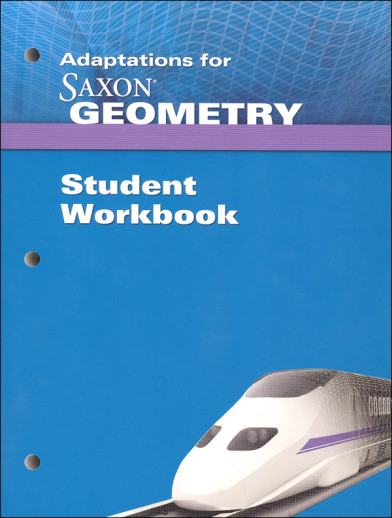We use cookies to make your experience better. To comply with the new e-Privacy directive, we need to ask for your consent to set the cookies. Learn more.
Saxon Geometry Adaptations Student Workbook
The Adaptations Workbook provides an alternative for students with special needs. This consumable workbook contains adapted versions of the practice problems found in the student text, with plenty of space provided for working the problems in the workbook. The adapted problems offer more visual prompts and clues for doing the problems.
Here it is! The long-awaited homeschool edition of Saxon Geometry. Since the release of the program for public school, we have been receiving phone calls wanting to know when it would be available for homeschool. Harcourt has listened and here it is. The wait has not been in vain as this program is as good and solid as the other Saxon math programs.
The hardcover Geometry student text includes all topics in a high school geometry course using the Saxon methodology of incremental development and continual review. Some of the topics covered include triangle congruence, postulates and theorems, surface area and volume, two-column proofs, vector addition, and slopes and equations of lines. There are 120 lessons divided into 12 sections, 12 Investigations, and 15 Labs in the student text. The table of contents is color-coded according to the math strands incorporated into each lesson.
To help students understand the flow of a lesson, the first lesson has yellow highlighted teaching boxes to explain the different elements that will be present in each lesson. Each lesson begins with a 'Warm-Up' in which students are given the skills and vocabulary which are prerequisite to this lesson. 'New Concepts' presents the new vocabulary with meanings and examples of the concepts along with solutions. 'Lesson Practice' lets students check to see if they understand the new concept and italicized reference numbers help students know what example demonstrated the concept for that problem. The 'Practice' section is where students practice new and old concepts together. Italicized numbers in this section refer to the lesson in which the concept is taught. This mixed practice serves as a good practice for state tests since the format is similar.
Some added features make this book very user friendly. The skills bank found in the back of the book highlights 22 different skills used in the lessons and are referenced by small numbers (ex. SB10) found throughout the warm-up and practice sections. For quick reference there are 6 pages of symbols, formulas, metric and customary measure, and properties, along with 2 pages of postulates and theorems. An extensive glossary rounds out the reference section. Pages of the text have very wide margins and occasionally the student will be given 'Hint,' 'Math Reasoning,' 'Math Language,' or even 'Caution' boxes with additional information for the lesson.
The Solutions Manual offers step-by-step solutions for all of the problems found in the student text. The Test Forms & Test Answers include tests to be taken each week along with a testing schedule. Solutions for test problems are found in the last half of this booklet. An Adaptations Workbook is now available, which provides an alternative for students with special needs. This consumable workbook contains adapted versions of the practice problems found in the student text, with plenty of space provided for working the problems in the workbook. The adapted problems offer more visual prompts and clues for doing the problems.
The question is, "How does Saxon Geometry compare to other geometry programs?" When you compare Saxon to Jacobs Geometry and BJU Geometry, you get a pretty good picture of the type of program Saxon has published. All 3 programs are comparable, covering the important topics that should be found in a strong geometry program. A good, solid introduction to trigonometry is also included in all 3, but Saxon includes a little more practice in this area.
With the release of the Saxon Geometry, you now have two different ways to complete your high school math. For the non-college bound student or the student who doesn't wish to pursue a math or science degree, use Algebra 1, Geometry, Algebra 2, and Advanced Math if you want or need a fourth year of math. If your student is college-bound in the area of math or science or they just really love math, use Algebra 1, Algebra 2, Advanced Math, and Calculus, and your geometry will be covered by the content found in these texts.
The Homeschool Kit includes the student text, solutions manual, and test forms and answers. The Homeschool Packet is just the test forms and answers. - Donna
| Product Format: | Trade Paperback Book |
|---|---|
| Grades: | 9-AD |
| Brand: | Saxon Publishers |
| ISBN: | 9781602775466 |
| Length in Inches: | 11 |
| Width in Inches: | 8.5 |
| Height in Inches: | 1.5 |
| Weight in Pounds: | 3.9063 |


I love Saxon Math!
I am teaching Geometry for the first time in several years, and I have quite a few Special Education students in my two classes. I think Saxon math is the best system available.